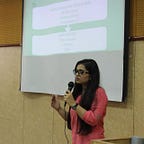Smart Shaker
Design Thinking Studio
Introduction to design thinking
Understanding the design thinking approach was a transformational shift in my way of approaching problems. Being a Computer Science major, my approach to solve problems would generally begin with the possible solution and thinking about the underlying technology to build the same.It helped me realize the importance of understanding the problem space better to deliver appreciable solutions.Working for the class assignments and practicing this approach helped me realize the gap between the technical approach of solutions and what customers would actually need.
1.Starting with a problem
We were given 3 choices of domains to focus on- commute, environmental impact, nutrition and health. The students in the team had different ideas in different domains and we spent a lot of time brainstorming on what possible problems we could target. We shortlisted a couple of ideas in different domains and selected one by some individual research on each idea and understanding possible feasibility, viability and do-ability of each idea. To facilitate the team arrive at one decision we individually rated the 3 aspects on scale of 5 and created a matrix with everyone’s scores. We chose the topic with the highest score- nutrition for disabled population.
What can we do to promote self-reliance and nutrition in basic cooking for the disabled population of Seattle area at their homes on their own time ?
— Reflection
It is difficult to get diverse personalities on same page. I helped the team arrive at a common decision with the matrix idea which helped take everyone’s views into account but also let the team take a decision.
We changed our audience to ‘elderly people’ with sufficient research in a very short period of time. We realized the access to disabled people to observe/interview would be difficult in course of the project and believed that it was not a significant pivot from our original idea since the data showed similarities in the nutritional needs and issues of the two.
How can we help the semi-independent, elderly, Asian population of the Seattle area or the people who cook for them to prepare nutritious food with regulated and healthy amounts of salt and sugar in their daily life?
Reason for focusing on the specified space
There was an overlapping preference for a problem in the team, we realized that this space has a lot of problems unsolved yet and were reassured by the research we did online. Some also had their personal experiences to share observing elders at home and their habits was also an underlying motivation.
2. Investigating the problem space
To understand the problem space better, we conducted our secondary research, field observations and online surveys. We triangulated our findings and prioritized our possible features of solution.
Our triangulated insights-
- Only focus on controlling salt and sugar (for now)
- Users need help controlling amounts
- Users need help building new habits
- For elderly: our product needs to be easy to learn and convenient to use
- For their children (or caretakers): our product allows them to check on parents’ consumption
— Reflection
It was challenging to gather our understandings and arrive at priorities. Realizing the difficulty is accessing elderly people to fill out the surveys, I initiated a different survey for the dependents who have observed their elders cook to strengthen our survey and gather more responses.
3. Ideation and brainstorming solutions
We came up with distinct possible ideas to solve the addressed problem ranging from apps to physical IoT devices. We brainstormed through sketches and storyboards. We agreed to work on Smart Shaker since salt shakers are familiar — a smart shaker will be easier to build into our users’ habits and Users can see, control and track how much they consume with the device easily.
— Reflection
Sketching is a great way to trigger one’s own thinking. I had an unreal perception that one needs to be artistic to sketch but realized that it can be done by anyone with any level of expertise and is a great tool to brainstorm on possible designs.
4. Prototyping and user-testing
Brainstorming on possible scenarios and UI screens, we built a physical prototype to understand and text the user-experience.
— Reflection
What you think is unambiguous and coherent is not necessarily unambiguous and coherent.
Our prototype
My key takeaways
Diverse teams have a lot to offer
Though being from diverse backgrounds and understandings there are ways to let everyone’s opinions count and still arrive at decisions as a team. We struggled initially but our coordination and teamwork improved with time and better understanding of each other. We could also rely on each other for our work which is was important. In the later half of the quarter the work divisions became effortless and team meetings got more productive and efficient.
I learnt a lot from within the team working with design and business person. Something very simple as what makes a elegant presentation, video editing to communication skills and team building.
Applying in future
Exercising the customer-oriented approach has helped me understand the gap between developers and customers. Developers approach solutions that excite the process of development for them without paying a heed to the actual demand of customers. Being on the technical side, I plan to take this approach into account in all possible projects in long run.
Something so simple as sketching, storyboards, paper prototypes have great potential to convey one’s ideas and thoughts. This skill is not only useful as a student but of great value as a working professional.
The team:
We are Global innovation exchange graduate students at University of Washington. My role on the team was that of a technical advisor and team builder. The other students on team had design and business backgrounds.
Rutuja Jadhav | Geoffery Waterhouse | Tianke Li
